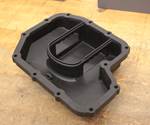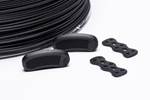Evonik, Lehvoss launch fiber-reinforced polyamide for SLS
Collaboratively, Lehvoss has developed Luvosint PA613 9711 CF, which is capable of being processed via standard laser sintering machines.

Laser-sintered components made from Luvosint PA613 9711 CF. Photo credit: Lehvoss
In cooperation with Evonik (Marl, Germany), Lehvoss (Hamburg, Germany) has developed a PA613 with compounded carbon fiber reinforcement — Luvosint PA613 9711 CF. The base polymer PA613 was designed by Evonik specifically for laser sintering. It is characterized by low moisture absorption, high temperature stability and — unlike PA6 — high process stability in laser sintering. The fiber reinforcement consists of high-strength XCF fibers, which have previously been used in Luvocom XCF products for injection molding. When it comes to powder production, approaches to particle technology were taken in order to preserve the fiber lengths in the individual particles as best as possible.
Powder bed processes, such as laser sintering, offer geometric freedom when printing components, which is necessary because the components originally designed for injection molding have complex geometries. Unfortunately, reinforced polymers in powder form are a contradiction. Fibers mixed dry into plastic powders can make do, but unbound, very thin fibers or mineral microscopically thin needles can be risky to handle from an occupational safety perspective. For this reason, they do not receive internal approval from industrial 3D printing processors.
Printing the Luvosint PA613 9711 CF requires a build chamber temperature of 195°C, which makes standard laser sintering machines suitable for processing. The material absorbs the wavelengths of CO2, diode or fiber lasers.
“The fact that the first automotive OEMs have already qualified for spare parts production shows that we are on the right track,” says Dr. Marcus Rechberger, product manager for Luvosint at the Lehvoss Group. “Nevertheless, in laser sintering, there still needs to be a lot of willingness to innovate in order to develop even more industrially relevant material — including machines optimized for this — in order to bring industrial 3D printing into ‘series.’”
Related Content
-
Natural fiber composites: Growing to fit sustainability needs
Led by global and industry-wide sustainability goals, commercial interest in flax and hemp fiber-reinforced composites grows into higher-performance, higher-volume applications.
-
Combining multifunctional thermoplastic composites, additive manufacturing for next-gen airframe structures
The DOMMINIO project combines AFP with 3D printed gyroid cores, embedded SHM sensors and smart materials for induction-driven disassembly of parts at end of life.
-
Bio-based acrylonitrile for carbon fiber manufacture
The quest for a sustainable source of acrylonitrile for carbon fiber manufacture has made the leap from the lab to the market.











